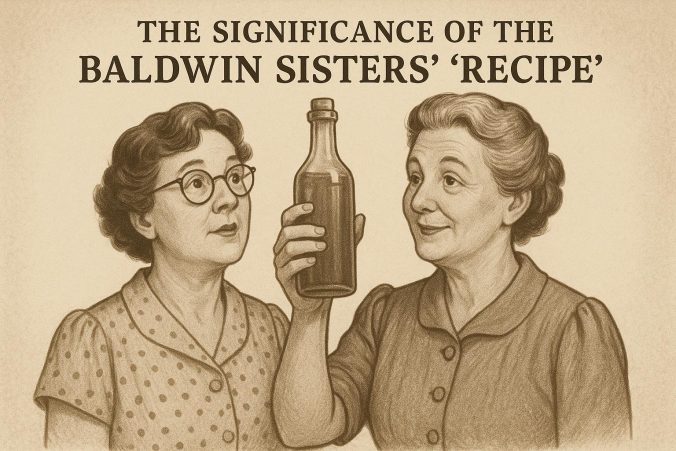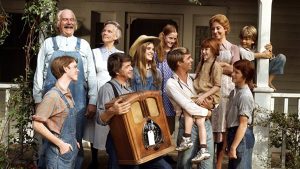The Baldwin Sisters’ “Recipe”
The Baldwin sisters’ “recipe,” a recurring element in the television series The Waltons, serves as a significant cultural touchstone. It plays a crucial role for both the characters within the show and its audience. Through their mysterious and often humorously handled concoction, the Baldwin sisters manage to bridge the past and the present within the narrative framework of the series.
Historical Context
The Waltons is set against the backdrop of the Great Depression and World War II, two pivotal periods in American history that added complexities to everyday life. This era was marked by economic hardship, societal changes, and efforts to rebuild lives amidst adversity. The Baldwin sisters’ “recipe,” which is a veiled term for bootleg alcohol, emerged during this time when the Prohibition law had officially made the production and sale of alcohol illegal in the United States.
In the absence of legalized liquor, clandestine operations like the Baldwin sisters’ offered a glimpse into the lengths people went to in order to preserve their preferences and cultural traditions. While it functioned as a source of comic relief in the show, the real-life implications of such activities were sometimes serious, involving law enforcement and societal censure. The sisters’ humorous and seemingly innocent misadventures allowed the viewers to explore these facets from the safety of their televisions.
Symbolism
Beneath its humorous exterior, the “recipe” embodies a set of complex symbols and thematic threads. One of the core representations of the “recipe” is that of tradition—the sisters’ continuous dedication to it reflects a steadfast allegiance to their family’s cherished practices. It is a safe-guarded family secret, passed down from their father, demonstrating the continuing importance of kinship ties and heritage even amidst new and changing times.
Moreover, the act of brewing this secret concoction stands as an act of rebellion, a gentle yet firm resistance to the societal norms and legal mandates of their time. It highlights the duality in human behavior—the public life dictated by regulation and the private indulgence in personal beliefs and practices. The divergence of public propriety and private enjoyment forms an intriguing narrative, engaging viewers in the complexities of human morality and legality.
Character Development
Throughout the series, much of the Baldwin sisters’ character development stems from their interactions with their “recipe.” Miss Emily and Miss Mamie Baldwin, the keepers of the “recipe,” are characterized by endearing eccentricities. Their lives thus revolve around maintaining not just their father’s tangible legacy but also his belief systems and values. Their attachment to the “recipe” becomes a part of their core identity.
The recurrent interactions between the Baldwin sisters and the townspeople—especially the Walton family—create numerous opportunities for character growth and exploration. John-Boy Walton, for example, often acts as a voice of reason and morality, yet his interactions with the sisters offer him moments of reflection and understanding of complex social dynamics. The sisters’ roles extend beyond mere comic relief, contributing to the overarching narrative by challenging the perspectives and moral compasses of the beloved Walton family.
Additionally, each character’s response to the “recipe” reveals their distinct outlook on life, authority, and community. These exchanges not only advance individual character arcs but also shed light on the rich tapestry of human interrelations during the era.
Cultural Impact
The narrative inclusion of the Baldwin sisters’ “recipe” in The Waltons extends beyond its plot-driven purpose, contributing significantly to the cultural and societal portrayal of the period. In a broader sense, it offers viewers historical insight into how communities navigated the collision of conservatism and the winds of social change. More importantly, it becomes a vehicle for discussing the contrasts and conflicts between traditional values and the modern age’s emerging ideologies.
What makes the “recipe” particularly impactful is its ability to engage diverse audiences. It is both a historical touchstone for those familiar with the Prohibition era and a source of reflection on current social customs and values. Moreover, in a modern reinterpretation, it invites dialogue on responsible choices and legal constraints.
The enduring appeal of the Baldwin sisters’ narrative explores themes that are as relevant today as they were in the time of its setting. These themes, contextualized within the series’ storylines, continually attract scholarly attention, offering a rich source for examining American family dynamics and societal structures from the 20th century.
The Baldwin sisters’ “recipe” thus functions as a multifaceted storytelling tool within The Waltons, weaving together threads of tradition, identity, and societal norms. Its presence enriches the narrative, providing depth and continuity across the series’ episodes. By examining this enigmatic element, viewers gain not just entertainment but also an appreciation for the complex nature of cultural heritage and the humor and humanity inherent in the efforts to preserve it. For those interested in exploring Prohibition’s impact on American culture, it is worth exploring educational resources and historical archives to gain deeper insights into this transformative period.


